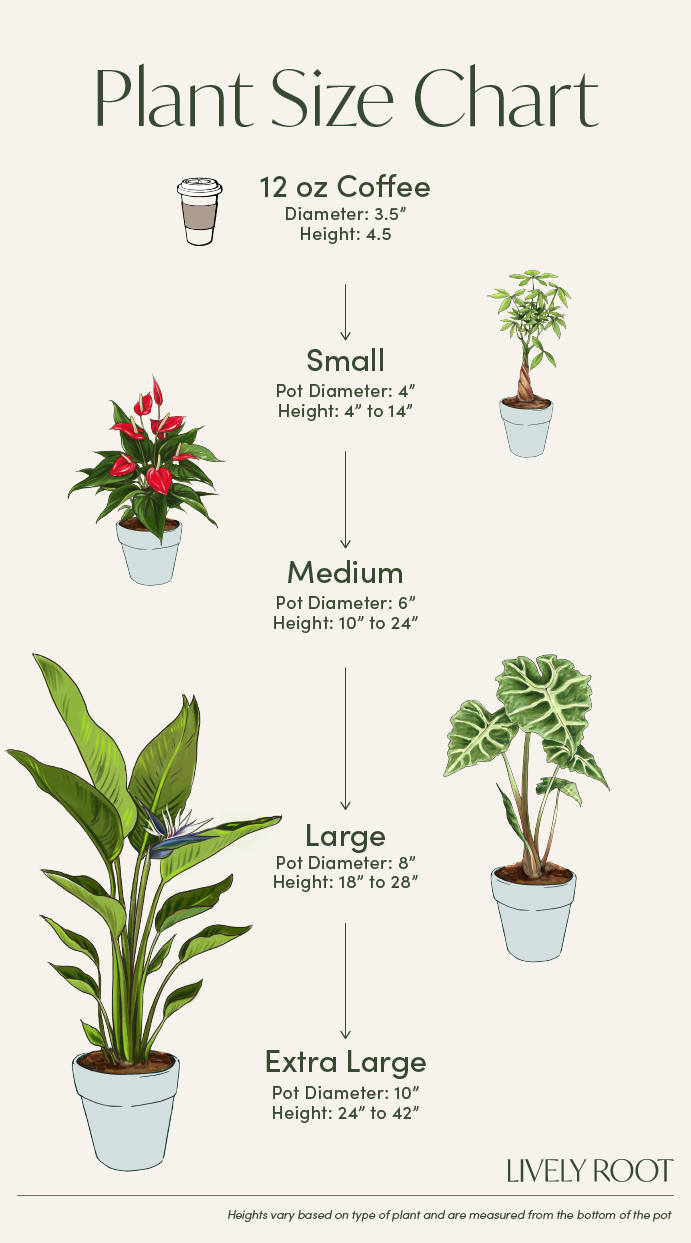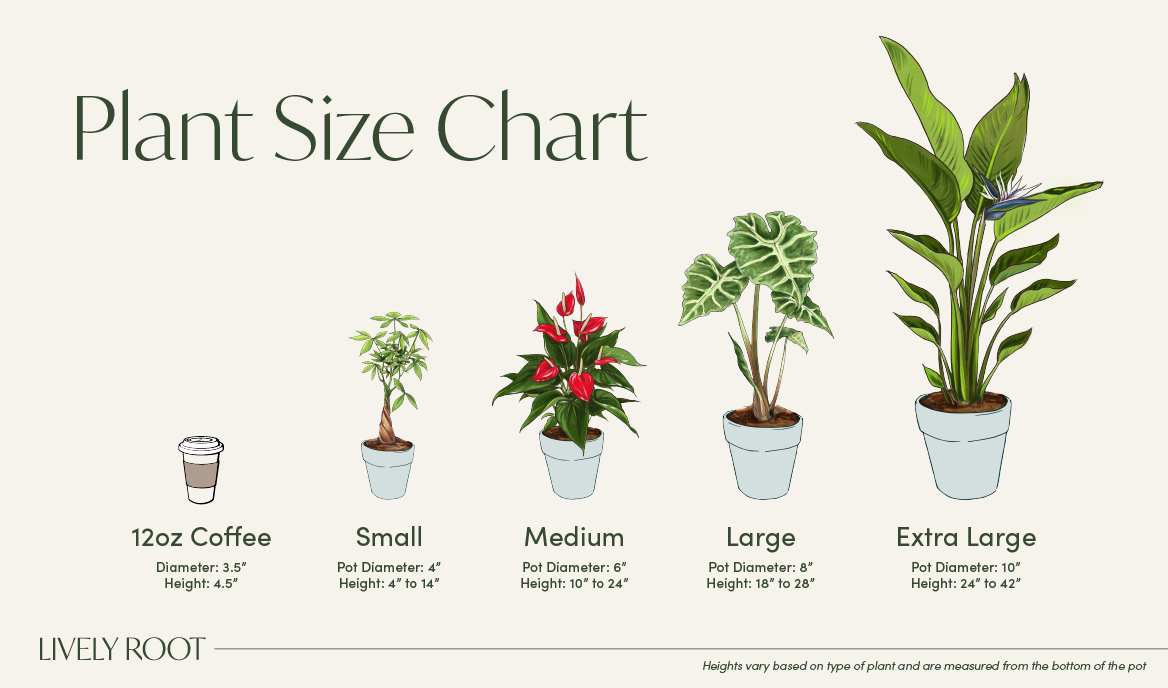

Also known as the "Cabbage Plant" or the "Good Luck Plant," this Cordyline Terminalis Hot Pepper will make any space feel more cheerful.
The color this indoor plant brings to any room is reminiscent of a tropical island with their hot pink leaves. Get the groove going in any place with bright light and high humidity.
Hawaiian Ti Plant Care Guide & Presentation

Can live in low light but performs better when exposed to medium light and also brings out the leaf color. Direct sun will burn leaves.
Water when you receive them. Enjoys being kept on the moist side but not soggy. Water well and then allow the soil to dry out.
Enjoys high humidity. Spritz occasionally.
Keep this plant in rooms where the temperature is a comfortable 65°F-95°F and avoid cold drafts below 50°F.
Outside: Keep them in part shade on a patio out of direct sunlight to prevent leaf burn where nights are above 50°F.
Apply at half-strength a liquid fertilizer especially formulated with a higher nitrogen formulation ( 24-8-16 or 20-10-20 N-P-K formulation) every two month during the growing season between early spring and fall. A slow release fertilizer can be used as a top dressing instead of a liquid fertilizer.
When receiving the Hawaiian Ti plant, do not repot immediately but wait at least 6-12 months or if the roots are beginning to get crowded and growing through the drainage holes.
Repot in the spring, using a 2 inches bigger pot to keep the roots drier. (Too big of a pot could cause the soil to dry slower, which is not helpful.)
Place a piece of screening at the bottom of the container over the drainage hole to secure the soil and allow to drain. Use a well-draining indoor potting mix with perlite to help with drainage.
Water your plant in the old pot before transferring over and let sit an hour.
Add soil to the bottom to elevate the root ball. Lift the plant and release the roots against the existing planter. Use a clean knife or garden trowel to wedge between the pot and the soil to loosen.
Inspect the root ball. Notice if there are any dead or rotting roots and trim off with sterile pruners. If the plant is rootbound, cut through the roots to alleviate continued encircling.
Ensure the plant is sitting about 1 inch below the edge of the pot to avoid water spillage. Add more soil and backfill around the sides by tamping down. Fill up to the soil line but not over.
Water thoroughly, leaving the soil damp but not soggy. If settling occurs, add more soil.
Water well to dampen the soil and let drain.
When watering your Hawaiian Ti plant, it's an excellent time to trim off any browning, yellowing, or discolored leaves. If they are getting leggy, prune back the plant to a foot above the soil. Branching will occur and encourage a bushier and fuller plant. Use these cuttings to propagate. Remove any debris from the soil and replenish if needed. To clean debris and dust off the leaves:
Place the Ti plant in a shower or tub.
Fill a watering can with a shower spout with filtered, bottled, or water free of chlorine and fluoride.
Shower the leaves, so each one is clear of dust and dirt.
Let the water drain and replace your plant in the decorative container.
In the spring or summer, take a stem cutting between 6-8 inches long with leaves attached using sanitized pruners.
Dip the cuttings in water, then in a rooting hormone.
Use a pot with drainage. and place the stem 1-2 inches down into the damp, well-draining, moist potting soil mix and tamp down around the stem to secure.
Set in bright, indirect sunlight while they are rooting.
Check the moisture and humidity each day and add misting to keep the soil moist while the roots establish.
After 6-8 weeks, roots will begin to establish. You can tug onto the stem to ensure the roots are secure.
Red Hawaiian Ti Plant: Overview
The Hawaiian Ti Plant (Cordyline terminalis 'Hot Pepper') is a fabulous shrub with slender stalks and clusters of long, pointed leaves. This tropical plant’s leaves are dark green, turning red to hot pink on the edges and undersides, ensuring a dazzling display. In the wild, this plant produces tiny, fragrant flowers that ripen into berries.
The Hawaiian Red Ti Plant belongs to the Asparagus family (Asparagaceae), and its botanical names Cordyline terminalis and Cordyline fruticosa are synonyms. Growing natively in the tropical regions of Hawaii, New Guinea, the Pacific islands, and Asia, the Red Ti plant can grow to 15 ft. tall in its native habitats and 3 ft. when grown indoors. The Cordyline Ti Plant lives up to 20 years or more when given the proper care.
Cordyline Hot Pepper care is simple; keep your plant happy with medium indirect light, high humidity, and regular watering. Because of the saponins contained in its foliage and stems, the Hawaiian Ti Plant is highly toxic to pets.
Considered a powerful Hawaiian good luck plant that plays a prominent role in this island’s rich culture, the Cordyline Hot Pepper is believed to repel negative energies and attract prosperity in Feng Shui.
Prized for its amazing tropical foliage, the Red Hawaiian Ti Plant is known under several different names, such as Cordyline Hot Pepper (Cordyline Red or Chilli Pepper), Cordyline Florida Flamingo, Cordyline Florida, and Hawaiian Ti Plant Florida.
Cordyline varieties include the palm-like Cordyline Australis Red Sensation and the glossy green Cordyline Fruticosa Glauca.
Hawaiian Ti Plant (Cordyline Fruticosa): Benefits
- Removes toxins like formaldehyde and benzene from the air
- Spectacular foliage with a tropical vibe
- Symbolizes prosperity and good luck
- Easy-care plant that’s suitable for beginners
Cordyline Fruticosa: Alternative Names
- Good Luck Plant
- Baby Doll Ti Plant
- Ti Plant
- Palm Lily
- Cabbage Palm
- Cordyline Fruticosa Florida
Hawaiian Ti Plant: Care Guide
Cordyline fruticosa care is straightforward and won’t take up too much time. Here’s how to keep this beautiful red plant in picture-perfect shape:
Watering and Humidity
Water your Cordyline Florida Red Ti plant well and then let the soil dry before repeated watering. This tropical beauty enjoys moderately moist but well-draining soil. High humidity is important for proper Hawaiian Ti Plant care. You can use a humidifier or group it with plenty of other plants to increase humidity.
Light and Temperature
While the Hawaiian Ti Cordyline plant can adapt to lower light, it grows best in medium, indirect light that also helps enhance its vivid leaf color. Never leave your Ti Plant in direct sun as it can burn its leaves.
The best temperature range for your plant is a warm and comfortable 65°F-95°F. As a patio plant, the Ti Plant thrives in Florida and other areas with high humidity and stably warm temperatures (USDA hardiness zones 10-12). Avoid locations with cold drafts.
Soil and Repotting
The best soil for your Hawaiian Ti plant is well-draining and nourishing. Mix in some perlite and peat moss to ensure root aeration and nutrition. Don’t repot your Cordyline fruticosa immediately. Wait until you see roots growing out of the drainage holes, or repot into a 2-inch larger pot in 6-12 months after getting your plant.
Feeding and Propagation
Feed your plant with a nitrogen-rich fertilizer diluted at half-strength every two months during the growing season. One of the benefits of Cordyline fruticosa is that it is easy to propagate. Take several 6-8-inch cuttings and plant them in moist, well-draining soil, dipping them in rooting hormone. Place the pots in medium light while keeping the soil evenly moist until the roots form.
Pruning, Cleaning, and Common Issues
The lower leaves of your Red Ti Plant may turn brown or discolored; trim these leaves to refresh your plant’s foliage. Prune to a foot above the ground to encourage lusher growth. Remove dust from the foliage using a shower.
Watch out for yellow, limp leaves that indicate overwatering. Check for mealybugs and spider mites and use an organic insecticide if necessary.
Cordyline Hot Pepper: Placement, Companion & Alternative Plants
The Red Ti plant, also known as Cordyline terminalis ‘Hot Pepper’, makes an amazing statement plant in any interior. Its dramatic foliage provides the perfect pop of color to transform your living space.
Best Locations & Uses
- Ideal easy-care plant for beginners and people with busy schedules
- A perfect plant for well-lit and humid spaces, like bathrooms with windows
- Great plant for homes without pets
- Wonderful tropical patio plant for warm and humid climates
- Exotic and low-maintenance office plant
Companion Plants
Create a harmonious green space by grouping your Cordyline Ti Plant with other large plants:
- Split Leaf Philodendron (Monstera deliciosa): A popular houseplant with large, fenestrated leaves, the Split Leaf Philodendron thrives in high humidity and medium sunlight.
- Variegated Sansevieria Laurentii (Sansevieria trifasciata 'Laurentii'): One of the best air-filtering plants, the Variegated Sansevieria Laurentii is super low-maintenance and has gorgeously patterned, spiked leaves.
- Dieffenbachia Tropic Snow (Dieffenbachia seguine): Growing up to 6 ft. tall, the Dieffenbachia Tropic Snow is an amazing statement plant with leaves in vivid green, cream, and white.
Alternative Plants
If you’re a pet owner, use these pet-friendly plants to set up a safe green oasis you can enjoy with your pet:
- Cast Iron Plant (Aspidistra elatior): Highly adaptable, the elegant Cast Iron Plant is the perfect pet-safe and easy-care plant for pet owners.
- Ponytail Palm Tree (Beaucarnea recurvata): A fun, fountain-shaped indoor palm, the Ponytail Palm Tree is both pet-friendly and super easy to care for.
- Peacock Plant (Calathea roseopicta): The Peacock Plant sports colorful, patterned leaves with a deep magenta underside, which fold at night, giving the impression that your plant is saying an evening prayer.
Get Your Hawaiian Ti Plant for Sale From Lively Root today
Enjoy the allure of the tropics brought to your doorstep by ordering the radiant Hawaiian Ti Plant for sale from Lively Root!


























